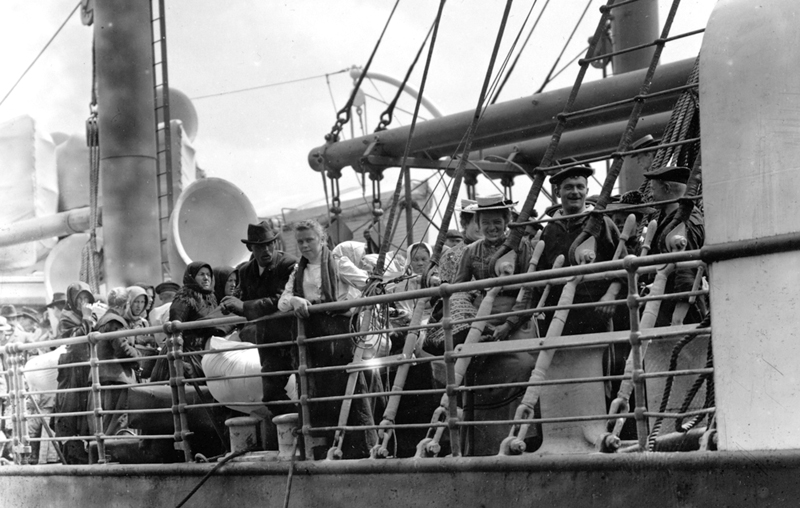
After Italy’s 1870 consolidation, il Risorgimento, the great wave of Italian immigration began. Italy had formed a common government, but not a nation. As one statesman put it, “Italy has been made. Now we must make Italians.” The south of Italy, the Mezzogiorno, spoke different languages, had been dominated for centuries by foreign powers, and had distinct cultures. Many in the north of Italy held southern Italians in disdain. The policies imposed by the north turned economic conditions in the already poor south dreadful. The lack of jobs and the threat of starvation compelled many to seek work in North and South America, and people became Italy’s most successful export.
From 1870 to 1920, 8.8 million Italians settled in three, new-world countries, the United States (5 million), Argentina (2.4 million), and Brazil (1.4 million). From 1870 to 1900, many went to Brazil and Argentina. After 1900, most entered the United States. Investments in the Americas created millions of unskilled jobs, and all three nations having pushed aside indigenous peoples, sought Europeans.
Italians in Latin America didn’t face the competition from earlier immigrants that they found in the United States. In Brazil, the end of slavery (1888) and expanding coffee plantations stimulated a government subsidized drive for Italians to replace emancipated Africans on plantations and in Brazilian mines. Treated little better than the slaves they replaced, Italians quickly turned to other pursuits. Today, the richest state in Brazil, Sao Paulo, has more people of Italian heritage than the founding Portuguese. Argentina believed that to govern was to populate, and Italian immigrants were welcomed. Pope Francis’s parents were Italian immigrants.
The United States was sparsely populated, and western migration facilitated by railroads plus enormous industrial growth drove the need for cheap labor. Italians worked the mines for the iron and coal demanded by new factories, built the skyscrapers, subways, canals, railroads and tunnels and worked in factories. Manual laborers constituted over ninety-percent of Italy’s migrants.
Italians arriving in New York found the Irish and Tammany Hall running the city. If an Italian wasn’t a mason, a tailor, a barber, or a shoemaker, or couldn’t open a shop with his family, he was consigned to manual labor. Southern Italians were eighty-percent of the immigrants to New York, often used as “human steam shovels,” constructing the skyscrapers and subways of New York. Women most often worked in the garment industry. Poor Italians hadn’t the money for transportation and had to find work immediately, triggering the padroni system of employment. Padroni were labor agents and sub-contractors building railroads, tunnels, and canals with crews of migrant laborers obtained by recruiting Italians in Italy for a percentage of their pay. Despite the padroni cut, men earned far more money in the States than they could’ve in Italy.
Early Italian immigrants were predominately males, evidence of their intention to return home. Italians were termed “Birds of Passage” because they made multiple trips to earn money in the States, the first U.S. immigrants returning to their country.
The literature of the period on Italian immigration to New York emphasized the squalor of living conditions. While undoubtedly true, life in New York attracted Italian ‘”Birds of Passage” to remain in the United States. Italians immigrated to neighborhoods where kin and friends had settled before. Factories transformed Italians from agricultural peasants into wage-earners. The Italian work ethic and belief in family encountered a degree of economic mobility and city-life social interactions not available to most men or women in the agricultural-orientated villages they left, and they found this new economic and social order attractive.
In 1911, the Dillingham Commission consisting of both Senate and House members decided that southern and eastern Europeans threatened the American way of life. and immigration laws in the United States were tightened. “Birds of Passage” Italians had to decide if they would stay in the U.S. and bring their families.
My father and grandparents emigrated from Naples to New York. As with the character, Guido Basso in my novel, Birds of Passage, an Italian Immigrant Coming of Age Story, both my grandfathers were ragmen. Their labor was dirty and backbreaking, but they were their own padroni. My father acquired just a seventh-grade education before he set out to work. Unemployed for a long period during the Great Depression, he finally landed a job in a warehouse. Working rapidly to impress the boss, he reached up for a box atop which a vase had been left. The glass knickknack slipped and shattered onto the concrete floor. My father was fired on the spot. Not deterred, he started his own business.
Growing up, if my father and I passed a man doing hard manual labor, he would say to me, “See that? Go to school.”
My mother was one of five daughters employed at home doing piece work so her family could earn enough money to leave the tenement. Eventually her family purchased a home in Brooklyn.
A number of readers have remarked about the strong female characters in Birds of Passage. I grew up amongst women with inner strength and generous hearts.
Many Italian-Americans stand upon the shoulders of those intrepid enough to make a better life in a new country. Birds of Passage is not about my family, but I’m old enough to have known people who were born in the nineteenth-century. In the novel I tried to capture how Italian immigrants of that generation thought and acted.






